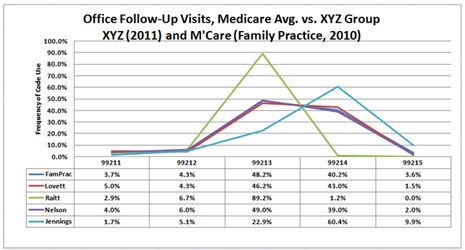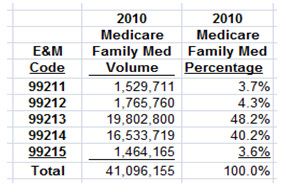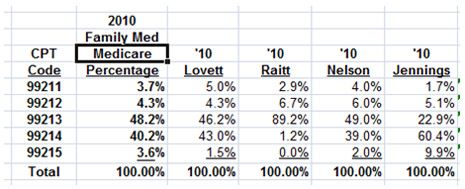Avoid Medicare Fraud Claims by Coding Correctly
Don't let your practice be caught up in Medicare's recovery program. It's a simple matter to examine your own coding patterns and compare them to national utilization data.
How would you like an investment that returns $7.20 for every dollar you invest? Our government has found just such an investment - healthcare providers.
HHS recovered $4.1 billion in healthcare fraud monies in 2011 to achieve their astonishing 720 percent return on investment. And like any investor on a winning streak, the feds are investing more - another $350 million is allocated to anti-fraud policing under the new healthcare laws.
You may believe you are beyond reproach if you don't order a mobile scooter for every patient or dump your patient records in the nearest landfill, but you should exercise caution in these cautionary times: what the feds consider "fraud" is much broader than your definition. E&M coding, for instance is a potential target; the 99213 and 99214 office follow-up codes were the top two CPT codes in terms of both charges and unit volume in 2010. Don't let your practice be caught up in Medicare's recovery program. It's a simple matter to examine your own coding patterns and compare them to national utilization data collected by Medicare. Knowing how you compare to others within your specialty is important in assessing possible exposure to recovery efforts.
Here are a few reasons you should conduct your own internal chart audits:
Avoid being an outlier. The following chart compares the office follow-up code utilization of four family physicians (Drs. Lovett, Raitt, Nelson, and Jennings) to Medicare's like data for family physicians. Medicare and its fraud contractors have the ability to perform such meta-analyses. Drs. Lovett (red line) and Nelson (purple line) code similarly to the national average (dark blue line). Dr. Raitt (green line) uses a 99213 to code nearly ninety percent of his visits, which makes him a larger target for a chart audit. Dr. Jennings (light blue line) uses 99214 nearly 50 percent more than the national average and 99215 at almost three times the national average. She also is a target for a chart audit.

Compare your E&M utilization. While staying under the bell curve will not make you audit-proof, it does decrease the odds that you will be targeted. Medicare produces a data file that contains E&M code utilization and charges by specialty by year, with the most recent year being available here.
To use this data file, extract the unit volume for each E&M code - organized by code set (i.e., office follow-up, hospital admissions, etc.) - into a spreadsheet. Sum the total, as shown below.

Next, calculate a percentage for each code. For instance, family medicine physicians coded a 99211 3.7 percent of the time when billing Medicare for an office follow-up visit in 2010.

Extract billing utilization data from your practice management system. Follow the same procedure to calculate the frequency for your utilization of each code.

These percentages can then be used to create a line charge, as shown earlier. While coding above, below, or at the national bell curve for your specialty does not mean you are coding accurately or not, knowing how your personal bell curve stacks up offers a clue to the likelihood of being targeted.
Coding and documentation audits. Regardless of whether your personal bell curve mirrors the national average, I urge you to have your coding and documentation audited on a regular basis. It is critical to know whether your CPT coding, ICD-9 coding, and documentation support one another. I subscribe to the "Noah's Ark" school of chart audits: at least two charts for every E&M code, at least twice a year, by at least two different certified coders. For frequently used codes such as 99213 and 99214, at least five charts should be audited.
Step One: Have your staff randomly pull the billing and chart documentation for recent patient visits for each E&M code. If you game the system by selecting which charts should be audited, you are only gaming yourself.
Step Two: Have a certified coder review each chart and provide a detailed report on your coding, billing, and documentation.
Step Three: Repeat step two, but use a different coder, preferably an outside coder. I say this not to insult certified coders but to protect you. All coders are not created equal, and E&M coding is much more art than science, in my opinion. Medicare will not give you the benefit of the doubt when reviewing your documentation, so you want these audits to be tough and instructive.
Step Four: Repeat this audit on a semi-annual basis. If you see no substantive differences in the findings of your two coders, you may elect to forego the second set of eyes. Still, I recommend that a second coder review your E&M coding at least every two years.
Summary
Remember the $7.20 return on investment the feds are getting on every dollar it invests in healthcare fraud? Medicare estimates it is but the tip of the iceberg. Because their definition of fraud and yours are quite different, it is incumbent on you and your practice to take steps to minimize exposure. Ensuring your E&M coding is in order is a prudent first - and ongoing - step.
Lucien W. Roberts, III, MHA, FACMPE, is vice president of Pulse Systems, Inc., and a former practice administrator. For the past 20 years, he has worked in and consulted with physician practices in areas such as compliance, physician compensation, negotiations, strategic planning, and billing/collections. He can be reached at lroberts@pulseinc.com.
Newsletter
Optimize your practice with the Physicians Practice newsletter, offering management pearls, leadership tips, and business strategies tailored for practice administrators and physicians of any specialty.
Asset Protection and Financial Planning
December 6th 2021Asset protection attorney and regular Physicians Practice contributor Ike Devji and Anthony Williams, an investment advisor representative and the founder and president of Mosaic Financial Associates, discuss the impact of COVID-19 on high-earner assets and financial planning, impending tax changes, common asset protection and wealth preservation mistakes high earners make, and more.